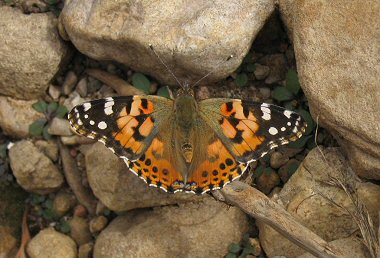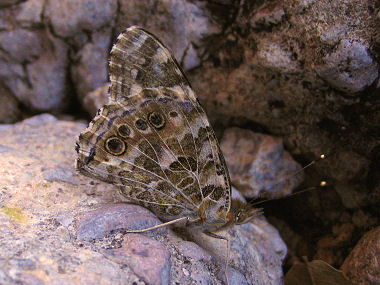| |
Painted Lady Butterfly
 |
 |
 |
|
|
| The Painted Lady Butterfly can be
identified by its color pattern. The upperside of the wings is
orange-brown with darker wing bases. The forewing has a black patch and
white bar on the leading edge, and the hindwing has a row of 5 small
black spots and sometimes has blue scales. The underside has a black,
brown, and gray pattern with 4 small eyespots. Painted lady butterflies
have a wing span of 2-2.9 inches. |
| |
 |
Natural
History |
 |
|
The Painted Lady begins its life cycle as
an egg that is the size of a pin head. Eggs are pale green and are laid
on thistle, mallow, or hollyhock leaves. The incubation period is 3 to 5
days at which time a caterpillar emerges. The caterpillar grows to 1.25
inches in length and is purple or black with yellow/green stripes with
long spines on each segment. It builds a silky, webbed nest as it feeds,
usually eating thistle, mallow, malva, hollyhock, sunflower, or canola.
As the larva grows, it sheds its skin (molts). When the caterpillar has
grown to the right size, it pupates. It hangs upside-down from a leaf or
branch, and attaches itself with a single silken string. An adult
butterfly forms from the caterpillar, whose internal structure changes
completely. The chrysalis becomes almost transparent when the butterfly
is about to emerge. An adult will emerge about 7 to 10 days after the chrysalis has formed. When an adult emerges from the split chrysalis, it
hangs upside down and pumps blood into its four wings, inflating them,
then it waits for its delicate wings to dry. It can fly a few hours
after emerging.
chrysalis has formed. When an adult emerges from the split chrysalis, it
hangs upside down and pumps blood into its four wings, inflating them,
then it waits for its delicate wings to dry. It can fly a few hours
after emerging.
|
The Painted Lady may be the most
widespread butterfly in the world. It can be found on every
continent in the world except Australia and Antarctica. |
The painted lady prefers nectar from plants 3-6 feet
high, especially thistles. Males perch on shrubs and hilltops and patrol
during the afternoon for females that are ready to mate. Females lay
eggs one at a time on the tops of host plant leaves.
 |
Back to Flora & Fauna |
|

